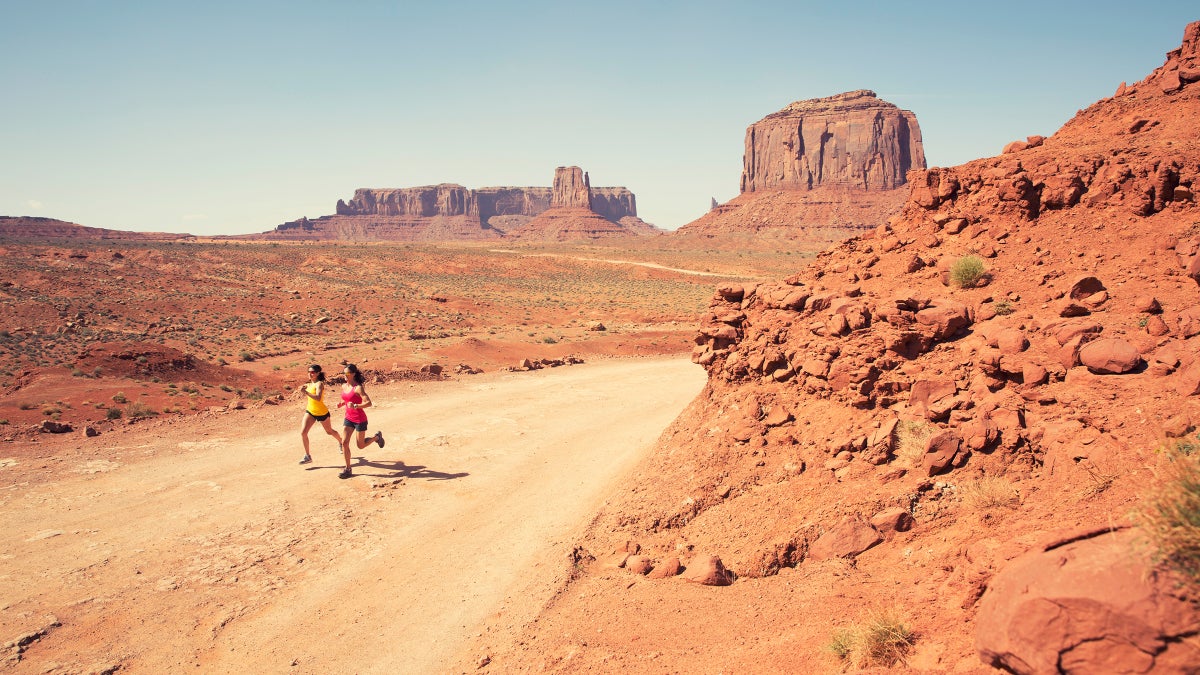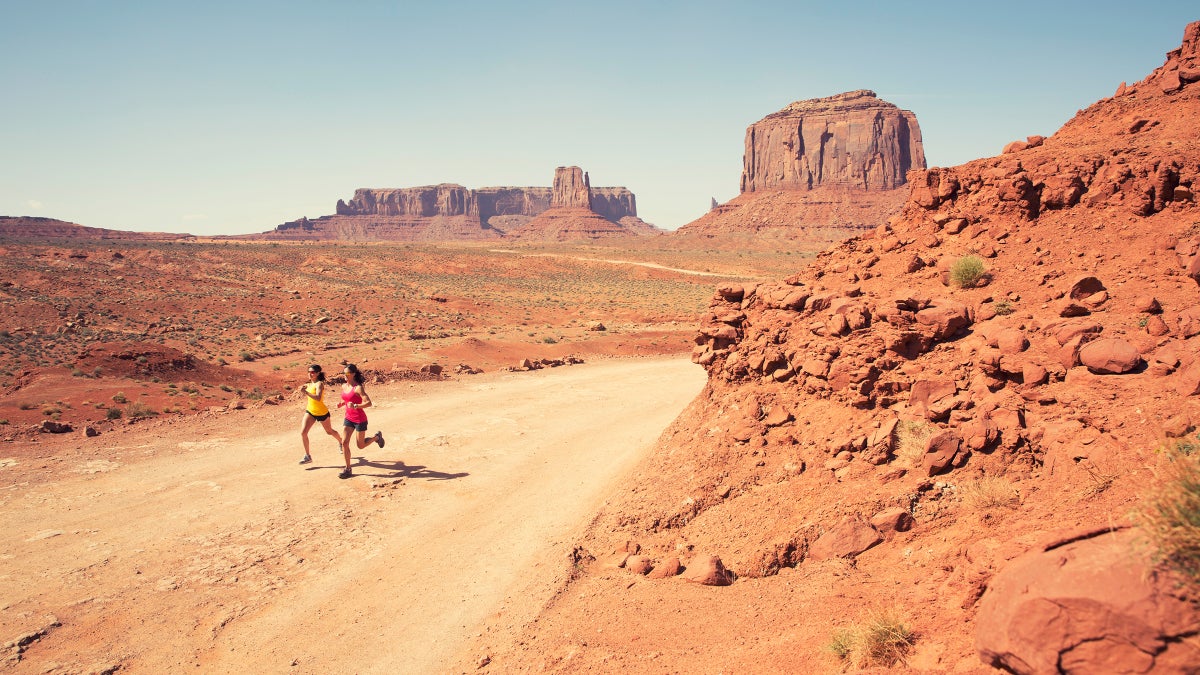No products in the cart.
Outdoor Adventure
How Hot Is Too Hot to Run?

This article was first published by PodiumRunner.com. To get more of their premium content along with your Outside subscription, join Outside+.
Runners don’t like heat. When the mercury rises, so too do many of us — early in the morning, that is, in an effort to get in our training before the heat sets in. Increasingly it seems, even rising before dawn is a futile effort to beat the heat. But, hot or not, we’ll get out in it, sweat, suffer and complain.
Sometimes, however, you have to take more dramatic action. Last weekend, when the Pacific Northwest was swept by a heat wave that produced conditions more commonly associated with Yuma, Arizona, than Eugene, Oregon, the U.S. Olympic Trials were repeatedly rescheduled “for the safety and well-being of athletes, officials and fans.”
A meet of the magnitude of the Olympic Trials being cancelled raises a question: how hot is too hot? Not just for well-conditioned pros, but for the rest of us?
To find out, PodiumRunner turned to the experts.
First, the good news. “If you’re well prepared and make adequate adjustments, you can safely exercise most days of the year,” says Brett Ely, a 2:38 marathoner and thermal physiologist at Salem State University, Salem, Massachusetts, whose research has focused on the impact of heat stress on exercise performance and health.
Normally, our core temperature is around 98.6. When we exercise, it starts to rise. “People can get up to about 104° in exercise without consequence,” she says.
Factors Beyond Fahrenheit
To avoid going over that threshold (or to slow the rate at which you approach it) a lot of factors come into play. One is the rate at which you can shed heat to the environment. This occurs in three ways: radiation away from hot skin, conduction (via cool air flowing across your skin), and evaporative cooling of sweat. “The heat you are creating, you can dissipate,” Ely says.
But under hot enough conditions, two things can impede this. One is humidity. “We can’t evaporate the sweat, says Chris Chapman, an exercise and environmental physiologist at the University of Oregon, Eugene. “It will just drip off and not provide cooling.”
The other is that we can gain heat directly from the environment, adding to that created by our own bodies. Anyone who’s ever tried to run in intense sunlight knows this. Not only can the sun itself be startlingly intense, but its heat can bounce back at you from sun-warmed surfaces.
Another way you can gain heat from the environment is if the air itself is super-hot. One of the surprises Pacific Northwesterners got during the recent heat wave (which peaked out at 116° in Portland) is that above about 110°, even in bone-dry humidity, a breeze is not your friend. Instead, the airflow may impart more heat to your skin via conduction than it removes via enhanced evaporation. Under these types of conditions, Chapman says, “[even] if you use a fan to cool yourself, you’re just increasing body temperature by blowing hot air on yourself.”
Wet Bulb, Steamy Runners
None of this is new. Back in the 1950s the U.S. Marine Corps combined it into something now known as the wet bulb globe temperature (WBGT), says Samuel Cheuvront, an exercise physiologist with entrinsic bioscience in Norwood, Massachusetts, who previously spent nearly 20 years working with the Army Thermal and Mountain Medicine Division, in Natick, Massachusetts.
The WBGT is the index that, according to NBC’s telecast of the Olympic Trials, USATF used in its decision to postpone the final session of the Trials from its scheduled start time of about 3:45 pm to 8:30 pm. (USATF didn’t respond to a phone call and an email from PodiumRunner seeking to confirm this.)
WBGT combines three measures of temperature. One is simply the air temperature. Another is a measure of evaporative cooling (related to relative humidity and air flow). The third is a measure of the intensity not just of sunlight, but of heat bouncing back at you from nearby surfaces (such as the track).
The result is stated as a temperature, but it’s a mistake to equate it to the type of “feels like” temperature you might see on the web. Due to the way it’s calculated, a WBGT as low as 90°F — far lower than the air temperatures recorded on the track in Eugene — is hot.
Based on this, the U.S. Navy has color-coded conditions ranging from green flag (low risk except to people unaccustomed to heat) to black flag (“physical training and strenuous exercise suspended for all personnel”).
The American College of Sports Medicine has also used it to recommend cancellation of competition at WBGTs as low as 82°F. That’s the level the Navy would only put as green flag, though the Navy’s flag system is more interested in safe training conditions than in safe conditions for endurance races, inherently more intense than most types of training.
A 2010 study in Medicine & Science in Sports & Exercise put the threshold even lower for large marathons. After studying eight marathons that either had to be canceled or produced large numbers of medical events, that study concluded that such marathons (which have large numbers of participants who would be on the course much longer than the pros) should be canceled if the WBGT at the start is over about 72°F.
If it sounds complex, it is. But it could be relevant in the upcoming Olympics. Tokyo is prone to black-flag conditions as I discovered some years ago, when I coached a Navy lieutenant stationed there. She was an elite marathoner, but training was very difficult in the summer because she got a seemingly endless number of black-flag days in succession and wasn’t allowed to run outdoors.
There are several ways to get a WGBT in the danger zone, says Cheuvront. The air temperature could, of course, just be Death Valley or Sahara Desert levels of hot. Or it could be not quite so wickedly hot, but with intense-enough sun to push you too high (probably the case in Eugene). Or the temperature could be still lower, but with very high humidity (what my runner encountered in Tokyo).
But it’s even more complex than that, he says, because the body takes time to build heat to dangerous levels. That means the black-flag warning zones are set for longer races, such as 10Ks, and marathons. That’s undoubtedly why the first events to be rescheduled in Eugene were racewalks and the women’s 10K.
“5K races are over pretty quickly,” Cheuvront says. The majority of people are finishing in 30 minutes or less.
Shorter races like the 400m, the 200m, and the 100m are over even more quickly. So long as runners aren’t already overheated from standing around in the sun before they start, there’s not much risk of them developing heat injury in the few seconds of the race.
How Do You Decide When it is Too Hot?
What does this mean for road runners seeking to enjoy the summer (especially after a year of COVID-19 lockdown)?
Clearly, no one can name a number on the thermometer over which you’re suicidal to go out for a run. It’s not that simple. And measures like the wet bulb that combine factors are confusing and not readily available unless you want to shell out several hundred dollars for a fancy thermometer.
Bottom line, it comes down to paying attention to your own body.
“If someone is well-adapted to heat, they’re probably okay listening to their bodies,” Ely says. Monitor how you feel: If you get dizzy, lightheaded, or uncomfortably hot, that’s the time to stop.
Be careful, however, if you get an unexpected heatwave that you’ve not prepped for. After a quick increase in temps, Ely says, ”you might be better off going for a swim or a walk.”
If you run in heat, adjust your pace as needed to maintain similar effort to what you’d feel on a cool day. “You might be 30 seconds to a minute a mile slower,” Ely says. If so, don’t worry. What you’re doing by running slower is reducing the amount of heat your body is producing as you run, allowing you to go longer before you have to quit.
“The harder you’re running the more metabolic heat you’re generating,” Chapman says. “[That] means you’re going to reach your capacity for heat tolerance quicker.”
You may also need to shorten your run and save longer outings for cooler days.
And, of course, keep hydrated and replace electrolytes, most importantly sodium. “If you sweat a lot, don’t skimp on the saltshaker,” Ely says.
Finally, realize that if you’ve spent weeks hiding from heat by running in the cool dawn, you won’t instantly become a great heat-runner. Adaptation requires some time. “It takes at least 7 to 14 days,” Chapman says.
The post How Hot Is Too Hot to Run? appeared first on Outside Online.
Source link

